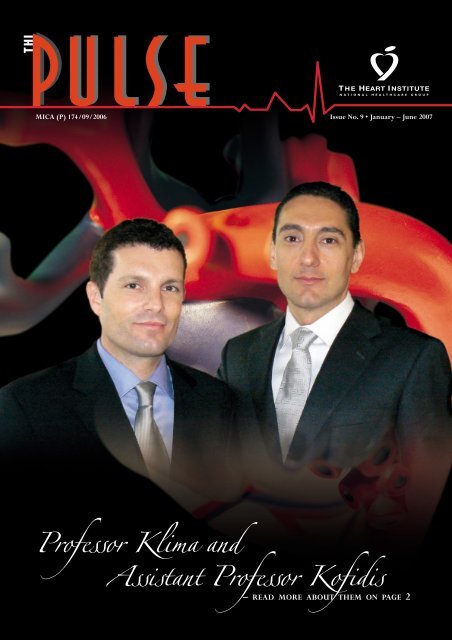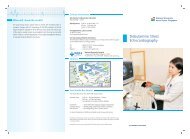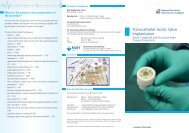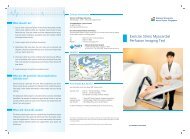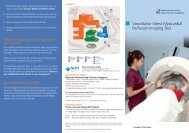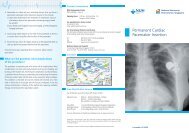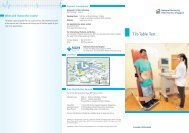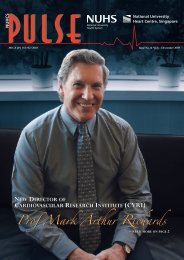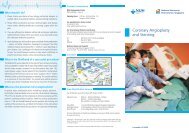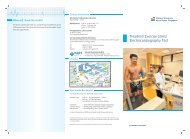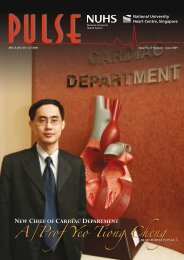Professor Klima and Assistant Professor Kofidis - nuhcs
Professor Klima and Assistant Professor Kofidis - nuhcs
Professor Klima and Assistant Professor Kofidis - nuhcs
- No tags were found...
Create successful ePaper yourself
Turn your PDF publications into a flip-book with our unique Google optimized e-Paper software.
MICA (P) 174/09/2006 Issue No. 9 • January – June 2007<strong>Professor</strong> <strong>Klima</strong> <strong>and</strong><strong>Assistant</strong> <strong>Professor</strong> <strong>Kofidis</strong>– READ MORE ABOUT THEM ON PAGE 2
in this issue0202040506070808090910111112121316FEEDBACKPlease direct your feedback toThe Editor, PULSEc/o The Heart InstituteNational University HospitalDepartment of Cardiac,Thoracic & Vasular SurgeryLevel 2, Main Building Singapore 119074Tel 6772 5565Fax 6778 6057Email The_Heart_Institute@nuh.com.sgEDITORDr Poh Kian KeongSINGAPORE PROVIDES TOP OF THECLASS HEART SURGERYINTRODUCTION OFDR THEODOROS KOFIDISTHE BENEFITS OF MINIMALLYINVASIVE THORACIC SURGERYTOUR DE BALIMULTIMODALITY IMAGING INNORTHEAST OHIOAMERICAN COLLEGE OFCARDIOLOGY 2007LIFEWISE EXHIBITIONAT THE HEART OF THE MATTERIN BRIGHAM AND WOMEN’SHOSPITALECG CASE STUDYPULMONARY HYPERTENSIONASSOCIATE PROFESSOR LIM YEANTENG DEPARTS NUHHOW CAN I FORGET NUH?EXCELLENT SERVICE AWARDCONFERMENT OF VISITINGPROFESSORSHIP BY SHANGHAIJIAOTONG UNIVERSITYDR RODOLFO C SOTOPROFESSIONAL LECTURERHAPPENINGS, ABSTRACTS ANDPUBLICATIONSAWARDS, CONGRATS,NEW DOCTORS ON BOARDDIRECTORYADVISORA/Prof Tan Huay CheemContents are not to be reproduced without thepermission of The Heart InstituteSingapore provides TSingapore is already aninternationally acclaimedhub in Asia for Biotechnology,Shipping <strong>and</strong> Banking. It is now onits way to become a hub forhealthcare services as well.In December 2006, a 57year old female US lawyer flewinto Singapore to get her heartvalve (mitral valve) repaired at theNational University Hospital. Onone h<strong>and</strong> she was repelled by theextensive costs for heart surgeryin the US, on the other it wasIntroduction of DAs Singapore is developing into a centre for patient care<strong>and</strong> academic advancement, Asst/Prof Theodoros <strong>Kofidis</strong> decidesto leave Europe <strong>and</strong> join the NUS. Theo has graduated from theLudwig-Maximilians University of Munich, Germany in 1996. Hecompleted his Internship at the Strong Memorial HospitalRochester (NY, USA) <strong>and</strong> Texas Heart Institute (Houston, TX,USA). He then proceeded to train in the Department of Surgery<strong>and</strong> Division of Cardiothoracic <strong>and</strong> Vascular Surgery of theHannover Medical School, Hannover, Germany from 1997–2002<strong>and</strong> 2004–2005 <strong>and</strong> was certified by the German Medical Councilas a Cardiac Surgeon in 2005. His training included minimal invasiveprocedures, OPCABs, assist devices, heart <strong>and</strong> lung transplantation,aortic surgery <strong>and</strong> clinical research. From 2002–2004 he was apostdoctoral fellow in the Dept. of CT-Surgery, Stanford University.He worked as a consultant cardiac surgeon in Hannover since 2005before joining NUS/NUH. He was a faculty of the HannoverMedical School in September 2006. His major areas of interestare cardiac surgery, minimal invasive cardiac surgery <strong>and</strong> heartfailure surgery (transplantation <strong>and</strong> assist devices).THI PULSE | 2
op of the Class Heart Surgery!difficult for her to find a surgeon who was willing to performsurgery on her. Being allergic to most analgesic drugs as well asblood thinners, the surgery was considered risky. Repair insteadof the replacement of the valve was of the better option. Beingaware of Singapore‘s medical expertise <strong>and</strong> facilities, she decidedto come to Asia for surgery.Not too long ago, it was a common practice worldwide toreplace failing heart valves with mechanical or biological valveprosthesis. Valve prostheses require either lifelong intake of bloodthinning drugs or a second surgery after 10 to 15 years. In the 80s<strong>and</strong> 90s more evidence suggest that the repair is superior to thereplacement in terms of short <strong>and</strong> long term survival. However,this requires experienced <strong>and</strong> skilful surgeons to be successful.<strong>Professor</strong> Uwe <strong>Klima</strong>, a heart surgeon from the National UniversityHospital in Singapore accepted this American as a patient,performed valve repair so that she could fly back home only fivedays after surgery.Prof <strong>Klima</strong> was trained in Europe <strong>and</strong> the US. He isinternationally recognised as an expert in state-of-the-art valverepair procedures, minimally invasive bypass surgery, thoracicorgan transplantation, as well as repair of aortic arch <strong>and</strong> thoracic<strong>and</strong> thoracoabdominal aorta.The successful treatment of the American patient was alsopublicized in the Singapore press. She was interviewed by TheStraits Times before she left <strong>and</strong> she emphasized, that she was gladthat she had the surgery done in Singapore <strong>and</strong> apart from theclinical excellence <strong>and</strong> affordable costs, she found dedicated doctorswho would “listen” to her.Dr Theodoros <strong>Kofidis</strong>He has early experience in the field of tissue engineering<strong>and</strong> stem cell technology for the heart. He has authored more than60 papers in peer reviewed international journals, book chapters,<strong>and</strong> introduced a series of patents. He is a reviewer of variousmedical <strong>and</strong> surgical journals including Circulation, JTCVS, JHLT<strong>and</strong> abstracts of annual conferences such as the AHA <strong>and</strong> Intl. Soc.for Heart <strong>and</strong> Lung Transplantation. He is Editor of the BioscienceJournal “Bio”, <strong>and</strong> was invited lecturer at Media Briefings of theAmerican Medical Association, the Bill Gates ResearchInstitute <strong>and</strong> the Dept. of Medical Engineering at Stanford. Hewas awarded various prizes <strong>and</strong> funding awards, such as theRockefeller Bioscience Award, the Bavarian State Scholarship, theAward of the European Thoracic Organ Transplantation Group, aswell as international surgical research awards.“An academic career brings about changes, sacrifices,sometimes losses. Some seek a high-tech environment, some seekvibrant culture, some seek gastronomic delicatesses, other seekfinancial incentives, or sunny beaches, while others are in the lookfor world-class science. Well, Singapore offers the entire package,<strong>and</strong> lives up to the quintessence ofthe tune: “If I can make it there...I’ll make it anywhere... ”In his short few months inSingapore <strong>and</strong> at NUH/NUS,Asst/Prof <strong>Kofidis</strong> has operated anarray of cardiac cases, serving theNUH <strong>and</strong> other hospitals. He hasrepresented NUH internationally.Further, together with Prof Uwe<strong>Klima</strong>, he has organized journalclubs, research meetings, roundsfor medical writing, cultivated relations to industry <strong>and</strong> otherscientific organizations, <strong>and</strong> promotes the establishment of aCTVSurgery scientific laboratory to study myocardial restoration.His immediate visions are to support the NUH <strong>and</strong> Dept. of CTVSSurgery with his cardiac surgery skills <strong>and</strong> enhance <strong>and</strong> supportthe Department’s scientific output, back-to-back with his mentor<strong>and</strong> friend, Prof <strong>Klima</strong>.THI PULSE | 3
The Benefits ofMinimally Invasive Thoracic SurgeryA/Prof John Tam, Department of Cardiac, Thoracic& Vascular Surgery @ NUHVideo-assisted thoracic surgery (VATS) or thoracoscopy hasbeen used to perform minor thoracic procedures for many years.Conventional indications for VATS include wedge lung biopsy,pleural biopsy, drainage of pleural effusion, pleurodesis,exploratory thoracoscopy, <strong>and</strong> thoracoscopic sympathectomy.With improvements in techniques <strong>and</strong> technology, thoracicsurgeons with advanced minimally invasive skills can apply VATSto perform major thoracic resections. These operations can betechnically challenging <strong>and</strong> often require expert training inminimally invasive surgery. In the United States, it is estimatedthat only less than 5% of major thoracic resections are currentlyperformed using VATS. The Department of Cardiac, Thoracic, <strong>and</strong>Vascular Surgery at the National University Hospital (NUH) inSingapore is now one of the few centers in the world that performsmajor thoracic operations using advanced minimally invasivetechniques.At NUH, current applications of minimally invasive thoracicsurgery include:1. Major anatomical pulmonary resections includinglobectomy, segmentectomy, <strong>and</strong> pneumonectomy for lungcancer patients2. Esophagectomy for esophageal cancer patients3. Lung volume reduction surgery for COPD patients4. Surgeries in the mediastinum, including resection ofmediastinal mass5. Mediastinal lymph node dissection6. VATS pleurectomy or decortication7. Pleural drainage <strong>and</strong> pleurodesis8. Lung <strong>and</strong> pleural biopsy9. Thoracoscopic sympathectomy for hyperhydrosis10. Diagnostic <strong>and</strong> therapeutic thoracoscopyMinimally invasive thoracic surgery confers manyadvantages to patients including significant reduction inpostoperative morbidity, mortality, <strong>and</strong> pain. In one research study,VATS lobectomy has significantly fewer complications thanconventional approaches. Operative mortality is rare. There is alsosignificantly less intraoperative blood loss with VATS.VATS procedures are performed with only three or foursmall incisions as opposed to a large thoracotomy incision. Themajority of VATS incisions are only near one cm in length. The useof thoracoscopy eliminates the need for rib spreading. As a result,patients have much less postoperative pain <strong>and</strong> no risk of ribfractures. Pulmonary function is also much better preserved aftersurgery. Patients are mobilized to walk on the first post-operativeday <strong>and</strong> they recover more quickly after surgery.These benefits translate to significantly shorter duration ofhospitali-zation <strong>and</strong> earlier return to full normal activities both athome <strong>and</strong> at work.Most importantly, VATS resections are shown to have equalor improved long term survival compare to open surgeries.With these advantages it is not surprising that patients <strong>and</strong>families commonly favor minimally invasive thoracic surgery overconventional approaches <strong>and</strong> they often express satisfaction withthe surgical results.Dr John Tam is a Consultant Surgeon in Thoracic <strong>and</strong>Esophageal Surgery at the National University Hospital inSingapore. He completed his surgical training in the United States<strong>and</strong> Canada. He is a Fellow of the Royal College of Physicians <strong>and</strong>Surgeons of Canada with Board Certification in Thoracic Surgery.Prior to working in Singapore, he completed the AdvancedMinimally Invasive Thoracic Surgery Fellowship at the Universityof Pittsburgh Medical Centre. He was also a lecturer in theDepartment of Surgery at the University of Pittsburgh.THI PULSE | 4
16 th ASEANCongress of CardiologyTour De BaliDr Eric Chong & Dr Poh Kian Keong, THI @ NUHThe 16 th ASEAN Congress of Cardiology was held during 18to 21 April 2007 at the Bali International Convention Center, theWestin Resort, Nusa Dua Bali, Indonesia.Many doctors, health professionals <strong>and</strong> amongst themcardiologists from all over ASEAN countries (including Singaporecardiologist from both private <strong>and</strong> public hospitals) attended themeeting. The scientific congress was held in a beautiful resortsurrounded by gardens, pools, fountains <strong>and</strong> Balinese architecture.The clean beach <strong>and</strong> breathtaking view of the South Indian Sea wasjust meters away.The congress was well organized with many concurrentsessions addressing various aspects of advancement in cardiology<strong>and</strong> recent research results. Our Singapore team also won the YoungInvestigator’s award. The congress which lasted two <strong>and</strong> a half dayswas a good learning opportunity. It was also a good time forpersonal interaction <strong>and</strong> socialization with fellow doctors fromneighboring countries meeting <strong>and</strong> for the junior doctors to meetup with seniors <strong>and</strong> learn from them.Balinese people are friendly <strong>and</strong> showed great hospitality.Several Indonesian patients whom A/Prof Tan Huay Cheem havetaken care of over the years took the time <strong>and</strong> effort to bring us ona tour around Bali despite their busy working schedules. We visitedKuta, a town area in Bali, had fresh local seafood <strong>and</strong> observed thememorial statue for the Bali bombing victims. We also visited alocal market in another town named Ubud (known for theirwooden h<strong>and</strong>icrafts <strong>and</strong> oil paintings) where we witnessedthe running of a furniture factory owned by one of A/Prof Tan’spatient. It’s of great satisfaction to see how the patient’s life wastransformed after seeing medical help – previously he has frequentchest pain <strong>and</strong> now he is doing well building high quality furniture.We spent our lunch at a well known local restaurant located in themidst of a paddy field called the “Dirty Duck”. With dining tablesarranged under traditional Balinese tents, it was so named becauseon the opening day of the restaurant, their first customer was a groupof dirty ducks passing across from the paddy field on a rainy day.We also partaked in the cultural night dinner organized atthe Garuda Wisnu Kencana Cultural Park. Surrounded by hugeancient stone walls in an alfresco dining area, we feasted ontraditional Indonesian cuisine <strong>and</strong> enjoyed performances featuringBalinese dance <strong>and</strong> songs. Representatives from each country putup a performance <strong>and</strong> our Singapore doctors cited poems <strong>and</strong> sanga song “I love Bali” penned by Dr Richard Ng. We had a trulymemorable night.The ASEAN Congress of Cardiology was an enjoyableexperience. The most fulfilling part of the trip was to realize thathow we have helped our overseas patients <strong>and</strong> experienced theirway of life in Bali. We look forward to next year’s meeting in Hanoi,Vietnam 2008.Background Dr Eric Chong is on the leftmost <strong>and</strong> Dr Poh Kian Keong is third from the left.THI PULSE | 5
Multi-modality imaging inNortheast OhioDr Ong Hean Yee, THI @ AHIn many ways Clevel<strong>and</strong> is similar to Singapore: greaterClevel<strong>and</strong> has also a population of more than three million; bothare multi-racial, multi-ethnic societies <strong>and</strong> both regard healthvisitors as a major economic force. However the similarities endthere. Clevel<strong>and</strong> used to be the industrial heart of America in thelate 19 th century with its steel <strong>and</strong> auto industry; Euclid Avenue inClevel<strong>and</strong> used to be the 90210 of the USA with the most expensivereal estate <strong>and</strong> was known as “Millionaire’s Row”. However withthe decline in manufacturing industry in the 1960’s, the city fellinto decline. Fortunately for the city, Clevel<strong>and</strong> Clinic, establishedin 1921, rose to be the top hospital for cardiology care for 12straight years in a row, as ranked by the annual U.S. News & WorldReport <strong>and</strong> became one of the largest employers in the city. Patientstravel from all corners of the world to seek advice <strong>and</strong> treatment.My plan was to complete a one-year fellowship inechocardiography <strong>and</strong> cardiac CT under the umbrella of multimodalityimaging fellowship. Learning echocardiography in the“Clinic” (as it is known by Clevel<strong>and</strong>ers) is exciting. We woulddivide our time between the operating theater, electivetransesophageal echocardiography, surface <strong>and</strong> stress imaging. Mostof the surgical cases were redo procedures or complex valvularheart diseases. There was a strong “just-do-it” attitude. I learnt fromfolks that wrote some of the echo text books. Dr Klein was ourresearch director <strong>and</strong> we took part in several projects includingmulti-modality pulmonary vein assessment.When I started my cardiac CT training in June, Dr MarioGarcia, the chief <strong>and</strong> pioneer of cardiac CT imaging was one ofthe warmest <strong>and</strong> most genuine man I have ever met. We werereading more than 20 complex cardiac CTs per day, with imagestransmitted from other States <strong>and</strong> also from a mobile CT scannerthat scan from nearby cities in Northeast Ohio. The departmentBackground Dr Ong Yean Yee is in scrub on the left.had purchased a Philips 64-slice scanner followed by the state ofthe art dual-source 64-slice scanner from Siemens. This promisedfaster scanning time (one of the Achilles heel of cardiac CT imagingwas the need for a faster scanning time to cope with a rapid heartrate). We had true real time reporting with our cardiologist,Dr Paul Schoenhagen, radiologist Dr Scott Flamm <strong>and</strong> others. Evenafter having read nearly a thous<strong>and</strong> CTs at that time. I realize thatthe more I see, the more I am aware of what I did not know – thelearning never ends.I had dragged my family over with trepidation, asstatistically, Clevel<strong>and</strong> was ranked # 9 in crime in the USA. Butfriends <strong>and</strong> colleagues already in Clevel<strong>and</strong> on HMDP reassuredus. I had spent many years during the “Troubles” in Belfast <strong>and</strong>knew there was a difference between reality <strong>and</strong> front-page news.We lived in a suburb in Clevel<strong>and</strong> which was 30 minutes by car towork. My predecessor Dr Chuang <strong>and</strong> Dr Lim, both from NationalHeart Center made sure we had a warm bed to sleep in on arrival.My two girls enrolled into Grade 1 <strong>and</strong> 3 (Primary 1 <strong>and</strong> 3)respectively <strong>and</strong> went to school in a big yellow bus that I used tosee only on TV. They made friends quickly; the schools (like theClinic) were a mini United Nations with children from all overthe world. They were in tears <strong>and</strong> had endless farewell parties bytheir friends in the weeks prior to our return.We were joined by two other fellows from National HeartCenter <strong>and</strong> in June, Dr Teo Swee Guan from NUH CardiacDepartment arrived with his family to start his vascular medicinefellowship. There was much camaraderie <strong>and</strong> as we had childrenof similar age, most of our activities were planned together. Eachseason in Ohio is strikingly beautiful in its own way. We were lessthan 4 hours by car to Niagara Falls <strong>and</strong> Frank Lloyd Wright’s iconicFalling Water house. Autumn was especially beautiful <strong>and</strong> poignantfor me as it meant that it was time to pack up. We left with a heavyheart but I will bring the Clevel<strong>and</strong> Clinic experience home withme to Alex<strong>and</strong>ra Hospital.THI PULSE | 6
NEW ORLEANS, LOUISIANAAmerican Collegeof Cardiology 2007Dr Edgar Tay, THI @ NUHMy prior impressionon post-Katrina NewOrleans was that therewould not be much to do.The internet postedreports that only about50% of people hadreturned after the Hurricaneonslaught. Also someof the hotels informed thatthe nice looking hotelphotographs on the webmay not be what they arenow. However, A/Prof TanHuay Cheem, Dr Poh KianKeong, Dr Melissa Co (our interventionist fellow from Philippines)<strong>and</strong> myself were fortunate enough to be given the opportunity toattend this important annual cardiac meeting. I arrived late at night<strong>and</strong> was greeted kindly by an affable cab driver who introducedme to the city whilst driving me. He had survived Katrina <strong>and</strong> hadnumerous short stories to share about the courage of his fellowmen <strong>and</strong> the devastation of their loved city. The first day was spentregistering <strong>and</strong> familiarising ourselves with the location. To oursurprise, the city centre had been cleaned up nicely: there wasalmost no trace what happened few years ago. That night, followingtraditional New Orlean styled dinner, we strolled down Bourbonstreet. This was an entertaining area with psychedelic neon lighting<strong>and</strong> loud music. There were also attractive dancers who gyratedwildly at the rhythmical beat of the drum <strong>and</strong> jazz musicians whoplayed fantastically. Interesting local street buskers, some of themchildren, were able to create a medley of songs with simpleinstruments such as glass bottles, combined with the traditionaltrumpet, trombones <strong>and</strong> drums. Their vocal rendition of “st<strong>and</strong> byme” was captivating in the small street corners.Day 2 to Day 3 was essentially packed with scientificprograms. We started the day early at 7am <strong>and</strong> attended a varietyof lectures. I attended the general cardiology updates while theothers attended smaller meet-the-expert sessions pertaining tospecific issues such as stent thrombosis, stem cell therapies etc. Iattended late breaking trials to keep abreast with the latest clinicallyrelevant information.ACC 07 was a year toherald the trials onCETP inhibitors. Thistherapy had showedpromise to raise HDLlevels <strong>and</strong> was meantto slow or reversecoronary or carotidplaque progression.However, the drug wastaken off the marketbecause of safety issues.We however haddetailed discussions onthe mechanism of the drug <strong>and</strong> the likely causes for failure. Therewas a silver lining, with new perhaps safer agents on the horizon.Another very important l<strong>and</strong>mark study, the COURAGE trial gaveus new insights on the treatment of chronic stable angina. As aninitial management strategy, percutaneous coronary interventiondid not reduce the risk of death, myocardial infarction, or othermajor cardiovascular events when added to optimal medical therapy.This study illustrated the importance of optimizing medicaltreatment for our cardiac patients.We present our studies to the international community.Dr Poh presented his research on real time three dimensionalechocardiography; Melissa represented us on the use of the Genousstents (coated with antibody to endothelial progenitor cells) in acuteST elevation myocardial infarction patients <strong>and</strong> I presented a studyon vascular stiffness of the ascending aorta. There was great interestjudging by the numerous scientists <strong>and</strong> clinicians who came to findout about our research. Aside from the intense scientific exchanges,we caught up with old friends <strong>and</strong> colleagues. The last part of thetrip was spent strolling along the banks of the Mississippi River forsome last minute shopping.This meeting was a great opportunity for academic exposurefor me. It shows the healthy explosion of research in cardiac science<strong>and</strong> therapeutics which allows us to further our knowledge <strong>and</strong>improve managing our cardiac patients in Singapore.THI PULSE | 7
Lifewise ExhibitionDr Edgar Tay, THI @ NUHAs part of our community outreachefforts, our Cardiac team participated inthe first NHG LifeWise Health Fair, The Artof Healthy Living, held at Suntec City on26 <strong>and</strong> 27 June where all the NHGinstitutions came together to offer varioushealth services to the busy workingpopulation. This event was warmly receivedby the members of the public. Our nursesfrom the cardiac centre were activelyinvolved in measuring the blood pressureof almost 450 participants <strong>and</strong> counsellingwhen necessary. There was also a display ofdiagnostic equipment like the exercisetreadmill test which attracted the attentionof many people.Our Consultant Cardiologist,Dr Teo Swee Guan gave a talk on “TheRhythm of Life – Keeping Your Heart InTip-Top Condition” This talk focused on thetopic on sudden cardiac death. It drew alarge crowd because of the recentlypublished reports of sudden cardiac deathsamong the community. Many of theparticipants came forth to seek furtherunderst<strong>and</strong>ing of the condition after the talk.Most of them also shared that the event waswell run <strong>and</strong> hoped that these events wouldcontinue in future.At the Heart of the MatterIN BRIGHAM AND WOMEN’S HOSPITALDr Eric Hong, THI @ NUHBrigham <strong>and</strong> Women’s Hospital (BWH), a teaching hospitalof the Harvard Medical School is situated in Boston, Massachuetts.I was honoured to be accepted into their MultimodalityCardiovascular program. Cardiovascular (CV) imaging hasexperienced major growth <strong>and</strong> technological advances recentlywith multimodality <strong>and</strong> hybrid imaging yieldingfused images. This include gated single-photonemission computed tomography (SPECT),positron emission tomography (PET), CTscanning for coronary calcification, CTcoronary angiography, carotid <strong>and</strong> peripheralvascular imaging <strong>and</strong> molecular imaging ofbiologic processes that is still in the preclinicalinvestigative phase.PET is increasingly used instead ofSPECT to assess myocardial perfusion in certaingroups of cardiac patients. PET in combinationwith computed tomography (CT) allowssimultaneous determination of anatomic stenosis detection <strong>and</strong> itsphysiologic manifestation on stress perfusion scans in a singleexamination. BWH was home to one of the world’s first 64-slicePET/VCT scanners. It can capture images of the heart <strong>and</strong>coronaries in fewer than 5 heart beats. In a single rotation, thesystem creates 64 credit card thin images, totaling 40 mm ofanatomical coverage. These images then combine to create a threedimensional view of patient anatomy. Functional, anatomical data,cardiac perfusion maps, CT coronary angiography <strong>and</strong> calciumscores can be acquired all in one setting. Since it is able to determinethe degree of the blockage, the PET/VCT scanner may helpphysicans plan treatment options such as medical therapy for minorblockages or a stent or bypass surgery for a more significantblockage. The adoption of PET <strong>and</strong> PET-CT imaging is accelerating; however,relatively few centres in the world havesuch extensive experience nor thevolume with these specialized imagingmodalities. The centre is investigatingusing a dual headed 64- slice CT tocharacterize plaque morphology <strong>and</strong>visualize stents. Thus, even members ofthe White House come to BWH for theircardiac evaluation!The training to date has beenrigorous but interaction with internationalpeers <strong>and</strong> forging mutually beneficial vendor relationship,business models have made my experience enjoyable. It has trulybeen an honour to work with a dynamic <strong>and</strong> talented group ofphysicians. Witnessing their commitment <strong>and</strong> dedication toimproving care for patients was truly inspiring.Although I am sad to leave BWH, I look forward to myreturn this summer. I am excited to apply what I have learnt toenhance the cardiology services in NUH <strong>and</strong> NHG.THI PULSE | 8
ECG Case studyDr Lee Li Ching & Dr Poh Kian Keong, THI @ NUHWHAT INVESTIGATION WOULD YOU ORDER?Transthoracic echocardiography revealed a flailposterior mitral valve leaflet with severe mitralregurgitation. The mitral regurgitant jet waseccentric <strong>and</strong> directed anteriorly. The patientsubsequently underwent mitral valve repair <strong>and</strong> hadan uneventful recovery.A 50 year old man presented with one week history ofshortness of breath on exertion. On examination, his BP was 120/80, HR was 140/min, irregularly irregular <strong>and</strong> there was apansystolic murmur at the apex, grade 4/6, radiating anteriorly.Clinically he was in heart failure. His presenting ECG is shownabove.DISCUSSIONIn patients with mitral regurgitation (MR) due toflail leaflets, the rate of development of atrialfibrillation (AF) was about 5% per year. Developmentof AF was independently associated with higherrisk of cardiac death or heart failure. In addition, inpatients undergoing mitral valve repair fordegenerative MR, preoperative AF was an adverse predictor ofearly <strong>and</strong> late survival. Therefore, besides treating AF to alleviatesymptoms <strong>and</strong> prevent thromboembolic event, it is important todetermine the underlying aetiology.ReferencesWHAT IS THE DIAGNOSIS AND UNDERLYING AETIOLOGY?ECG showed narrow complex irregular tachycardia with noobvious P waves. It was consistent with the diagnosis of atrialfibrillation. This was likely to be secondary to mitral regurgitationdetected on physical examination. He was treated for congestiveheart failure precipitated by fast atrial fibrillation.1. Grigioni F, Avierinos JF, Ling LH, Scott CG, Bailey KR, Tajik AJ, Frye RL,Enriquez-Sarano M. Atrial fibrillation complicating the course of degenerativemitral regurgitation: determinants <strong>and</strong> long-term outcome. J Am Coll Cardiol2002 Jul 3;40(1):84-92.2. Alexiou C, Doukas G, Oc M, Oc B, Swanevelder J, Samani NJ, Spyt TJ. Theeffect of preoperative atrial fibrillation on survival following mitral valve repairfor degenerative mitral regurgitation. Eur J Cardiothorac Surg. 2007;31(4):586-91Pulmonary hypertensionMs Margaret Choong, Cardiac Dept @ NUHFrom Left Dr Edgar Tay, Mr Mohd Amin (Pt Activist),The date 07/07/07was a significant dayfor our pulmonaryhypertension patientshere in THI. We hadorganized our firstpulmonary hypertensionsupport groupmeeting. The programwas simple, with patient<strong>and</strong> physician’s participation in a fun game <strong>and</strong> a more seriousinformative session. The feedback that was gathered shows thatthey enjoyed the information learnt about the emerging drugs fortreatment, giving them hope for a longer lease of life. Some wereeven busy taking notes on their PDA!!For one particular patient, it was especially momentous ashe is the patient activist <strong>and</strong> intends to drive the support group.He mentioned in a near tearing moment during his speech, thatthe event, is the beginning of a dream come true.The aims of the support group, put simply, is to promoteawareness of the disease <strong>and</strong> it’s treatment <strong>and</strong> to encourage patientto actively participate in their own care <strong>and</strong> advocate for the causeof their disease treatment. The longer term goals, as put by thepatient activist, Mr Muhammad Amin, is also to raise funds <strong>and</strong> adim hope of getting governmental help. It will be a long road aheadfor the group as treatment is expensive, although many more newdrugs are developed to treat this disease. All is not lost, as newtrials are on the way, <strong>and</strong> our own team in NUH is working hard atfinding novel treatments that are cost effective <strong>and</strong> sustainable forour patients. Keep a look out for future papers by our team!!THI PULSE | 9
Associate <strong>Professor</strong> Lim YeanTengdeparts NUHDr James Yip, THI @ NUHA/Prof Lim Yean Teng or moreaffectionately called Y.T. leaves the NationalUniversity Cardiac Department after 20years of public service. In his own words:“I am the last link from Day One NUH tilltoday in the cardiac department.”Y.T.is known in Singapore, China<strong>and</strong> the Asia Pacific region as a “peerless”interventional cardiologist. He is codirector<strong>and</strong> founder of the Singapore <strong>and</strong>Asian Interventional CardiovascularTherapeutics Meeting <strong>and</strong> is a regular feature in many internationallive course meetings. A little known fact is that his initial trainingwas in Nuclear Cardiology for which he was still reporting regularlyup to the eleventh hour of his departure in NUH <strong>and</strong> still helpsout as a visiting consultant. He joined as a registrar in thedepartment in 1988 <strong>and</strong> rose within ten years to become its chiefin 1999. In 2003, he was called upon for higher service <strong>and</strong> wasappointed Chairman Medical Board (CMB) of NUH. No soonerhad he taken over this mantle did the SARS outbreak occur <strong>and</strong> hisabilities were severely tested. Although some of our doctorsdeveloped SARS in NUH, there were no fatalities or serioustransmissions to the community under his leadership.I remember Y.T. most as a leader who walks his talk. The“buck” literally stops with him. I remember an occasion when anelderly lady (who was not his patient) needed a bedpan. As all thenurses in the ward were busy attending their duties he personallywent to the utility room grabbed a bedpan <strong>and</strong> assisted the patient.Above A/Prof Lim Yean Teng is in the centre.A few minutes later a few red faced nurses appeared to assist theCMB in his ‘duties’. Dr Adrian Low remembers an occasion whena relatively young man who was dying from a heart attack, Y.T.spent half <strong>and</strong> hour squatting with his family members outside thecoronary care unit comforting the family.Despite his departure from full time service in the hospital<strong>and</strong> the university, Y.T. is still a visiting consultant who comes backEVERY week to lend his expertise in the cath lab training ourinterventional fellows. He is known for his high <strong>and</strong> exactingst<strong>and</strong>ards in cath lab <strong>and</strong> many a Fellow would have painful storiesto tell of being ‘dressed down’ for their shoddy work. Some of†theselifelong lessons they would care to repeat with pride as they inturn impart their skills to others.On behalf of our chief, A/Prof Tan Huay Cheem, we wishyou God’s blessing <strong>and</strong> success in your new practice, CardiologyAssociates in Mount Elizabeth Hospital.THI PULSE | 10
How can I Forget NUH?Dr Ronald E Cuyco, THI @ NUHIt all started when Hazel Penafiel, also a Filipino <strong>and</strong> a formerclinical fellow of the NUH-Cardiac department gave me the emailaddress of the chief of the department – A/Prof Tan Huay Cheem.Right away, I sent him a letter of my intent to have further trainingin cardiovascular imaging in this institution <strong>and</strong> to my surprise, injust a couple of days I obtained a positive response. I am alsoprivileged to be sponsored by the Singapore Cardiac Society.Without any hesitation, I came to Singapore filled withexcitement on the 30 May 2006. Immediately, I went to NUHwhere I was introduced to the consultants <strong>and</strong> staff, <strong>and</strong> had a tourof the hospital. On that very day I said to myself: “I was in the rightplace at the right time with the right people.” Such an impressionnever faded as the time went by, for it even surpassed myexpectation of the institution’s ability to train foreign cardiologistslike myself.The day I met my supervisor was a great day for me too. Itwas the day that I received details of my training schedule. I wasfortunate that he is a cardiologist trained in cardiac magneticresonance imaging (CMR). He is also kind, intelligent <strong>and</strong> adedicated mentor. I remember his sacrifices of spending manySaturdays with us for specially arranged teaching sessions on cardiacMRI, instead of spending time with his kids <strong>and</strong> family. And not toforget his staying late with us in weekdays, teachingechocardiography <strong>and</strong> cardiac CT (angiography). There are noAbove Dr Ronald E Cuyco is fourth from the right.words I can think of to express my utmost gratitude <strong>and</strong> thanks toDr Chai Ping.My interest in research was also well supplanted especiallywith the guidance of A/Prof Ling Lieng Hsi. Though, it would ‘eatup’ my weekends because I had to come to the laboratory for datacollection, I enjoyed it very much. I learned a lot from Prof Lingespecially about basic <strong>and</strong> advanced concepts in echocardiography,even if it would mean staying in the laboratory until 9 or 10pm.Thank God if it is Friday, because we would have free dinner firstin the medical lounge.I was very fortunate to have been given the chance to havemy training in non-invasive cardiovascular imaging at NUH. Notto mention that the Heart Institute is well equipped <strong>and</strong> filled withcardiologists who are also experts in their respective fieldsof specialization, such as Dr James Yip, Prof Chia Boon Lock <strong>and</strong>A/Prof TC Yeo.As a trainee, how can I forget NUH ?Excellent Service AwardSusan Lam, Nursing Officer, NUH Coronary Care UnitExcellent Service Award 2006Star award Aik Foon Lan, EuniceTeo, Kee Li Leng, Lo Chew Yong,Susan Lam & Zhao JianxinGold award Catherine LabalanMartagon & Nyeo Hui QingSilver award Betsy Thomas,Editha Erago Aquino, Hamimah BteSamad & Maria Theresa TabladaErpeloEXSA, an Excellent Service Award, is a national award that recognises individualswho deliver outst<strong>and</strong>ing services. The purposes of the award are to inspire service staff toscale new heights <strong>and</strong> to develop service models for others to emulate. It creates servicechampions, recognises efforts of service staff <strong>and</strong> professionalizes services. In 2006, 12 ofthe CCU (NUH Coronary Care Unit) nurses were awarded EXSA. This is despitechallenging circumstances in the setting of a crowded CCU.Besides attending to the medical needs of sick patients, CCU nurses have also toalleviate emotional <strong>and</strong> psychological concerns of patients. Our nurses were able to carrysmiles <strong>and</strong> to lend listening ears to patients <strong>and</strong> their families despite the busy <strong>and</strong> oftenstressful working environment. For example, a patient complained of coldness of herfeet. The nurse made a special effort of getting the patient a pair of socks from a convenientshop to get her a pair of socks. This simple gesture was much appreciated.Each EXSA recipient has made NUH Coronary Care Unit proud. Heartiestcongratulations to each one of them (Four Silvers, Two Golds <strong>and</strong> Six Stars). By adheringto the NUH mission, CCU nurses continue to hold the interest of patients paramount <strong>and</strong>provide excellent services to our patients.THI PULSE | 11
Conferment ofVisiting <strong>Professor</strong>shipBY SHANGHAI JIAOTONG UNIVERSITYA/Prof Tan Huay Cheem was conferred Visiting <strong>Professor</strong>shipof Shanghai Chest Hospital in June 2007. The Shanghai Chesthospital is affiliated to Shanghai Jiao Tong University, a prestigiousacademic institution in the city. A/Prof Tan has been active in theChinese interventional cardiology arena <strong>and</strong> has participated asfaculty in numerous meetings there as both lecturer <strong>and</strong> operatorperforming live demonstrations of percutaneous coronaryintervention. Very fluent <strong>and</strong> effective in M<strong>and</strong>arin, Prof Tan ispopularly known in many parts of China <strong>and</strong> has trained severalChinese interventionists in the past few years. The appointmentceremony was chaired by Prof Feng Yun, the President of thehospital, who praised Prof Tan for his “outst<strong>and</strong>ing contributionto the development of intervention cardiology in China”. He looksforward to greater cooperation between Shanghai Chest Hospital<strong>and</strong> The Heart Institute @National University Hospital.Dr Rodolfo C Soto<strong>Professor</strong>ial LecturerAbove A/Prof Tan Huay Cheem is second from left.A/Prof Tan Huay Cheem was accorded the rare distinction ofbeing the first foreign guest speaker for the Dr Rodolfo C Soto<strong>Professor</strong>ial Lecturer at the recent Philippines Heart AssociationAnnual Scientific Meeting. Dr R Soto is recognised to be the Fatherof interventional cardiology in the Philippines <strong>and</strong> is well respectedby his peers <strong>and</strong> colleagues. Cited by Dr Myra Torres, the organisingchairperson for the meeting, Assoc <strong>Professor</strong> Tan was described as“an achiever who has carved a niche in the Asian cardiology circle.A reputable <strong>and</strong> prominent cardiologist, lecturer, author <strong>and</strong>professor, he has made strides that took him to places.” Assoc ProfTan spoke on the topic of “Managing Coronary Artery Disease inthe 21 st Century: Diagnostic <strong>and</strong> Therapeutic Challenges” to apacked audience <strong>and</strong> was presented with a commemorative plaqueby Dr R Soto himself at the end of the lecture.THI PULSE | 12
happenings1ST NHG PACEMAKERS ANDDEFIBRILLATOR WORKSHOP6 JANUARY 2007GP SYMPOSIUM10 MARCH 2007WORKSHOP ON CHESTTUBE AND CENTRAL LINEINSERTION31 MARCH 2007YOUNG INVESTIGATOR AWARD FINALISTSAT SINGAPORE CARDIAC SOCIETY19TH ANNUAL SCIENTIFIC MEETING17 – 18 MARCH 2007NHG LIFEWISE EXHIBITION26 – 27 JUNE 2007HEART FAILURE SYMPOSIUM FORPATIENTS AND CAREGIVERS28 APRIL 2007THI PULSE | 13
abstractsAMERICAN COLLEGE OF CARDIOLOGYSCIENTIFIC SESSIONS 2007, NEW ORLEANS,24-27 FEB, 20071. Systolic Tissue Doppler Velocity of the Ascending Aorta isan index of Vascular Remodeling <strong>and</strong> Stiffness.Tay EL,Gong LL, Daw HY, Ling LH.2. Novel Assessment of Aortic Stenosis Using Real-time ThreeDimensional Echocardiography: Comparison ofContinuity Equation Derived Aortic Valve Area withPlanimetry. Poh KK, Solis J, Flaherty M, Kang YJ, LevineRA, Jung J.3. Safety <strong>and</strong> Efficacy of the Use of Endothelial ProgenitorCell Capture Stent (Genous Bio-Engineered R Stent) inthe Setting of Acute Myocardial Infarction: A Clinico-Angiographic Follow-up. Co M, Lim YT, Low A, Lim J,Lee CH, Lim IH, Tay EL, Tan HC18 TH ANNUAL SCIENTIFIC SESSIONS OF THEAMERICAN SOCIETY OF ECHOCARDIOGRAPHY,SEATTLE, USA, 16-20 JUN, 20071. Left Ventricular Vortex Formation Index as a NovelPredicator of Myocardial Performance after Exercise. PohKK, Tournoux FB, Neilan TG, Ton-Nu TT, Wood MJ2. Myocardial Adaptation <strong>and</strong> Efficiency in response toIntensive Physical Training in elite Speedskaters. Poh KK,Tournoux FB, Ton-Nu TT, Neilan TG, Picard MH, WoodMJ3. Left Ventricular radial Systolic function is Impaired inAsymptomatic Patients with obesity <strong>and</strong> Normal ejectionfraction. Chen AA, Neilan T, Poh KK, Tournoux F,Moukarbel GV, Kaplan LM, Semigran MJ, Wood MJ, WangTJ, Scherrer-Crosbie M4. Longitudinal Mitral annulus velocity before <strong>and</strong> afterpericardioctomy in patients with contrictivepericardition.Dal-Bianco J, Ling LH, Sundt TM, BarnesME, Oh JK.EUROPEAN SOCIETY OF CARDIOLOGY CONGRESS2007, VIENNA, AUSTRIA, 1-5 SEP 20071. Long-term efficacy <strong>and</strong> late arrhythmia recurrences withwide circumferential electrically isolating pulmonary veinablation for persistent <strong>and</strong> permanent atrial fibrillationSeow SC, Lim TW, Koay CH, Ross DL, Thomas SP2. Attenuation of Left Ventricular Vortex Formation Abilityin Heart Failure. Lee LC, Tan YL, Chia BL, Poh KK3. A comparison of the use of endothelial progenitor cellcapture stent <strong>and</strong> a bare metal stent in the setting of acutemyocardial infarction.Co M, Tay E, Tan HC, Lim YT, LowA, Lee CH, Lim J, Lim IH4. Diabetic patients without baseline renal impairment areat increased risk of developing contrast inducednephropathy post percutaneous coronary interventionChong E, Shen L, Tan HCCHEST 2007, CHICAGO, USA 20-25 OCT, 20071. Vortex Formation Index in Heart Failure: Novel Role ofTransthoracic Echocardiography in Assessing LeftVentricular PerformanceLee LC, Tan YL, Tan HC, Yeo TC,Chai P, Low A, Chia BL, Poh KKpublications1. Eur Heart J. 2007 Jan;28(1):19-25. Epub 2006 Nov 28.Pretreatment with intracoronary adenosine reduces theincidence of myonecrosis after non-urgent percutaneouscoronary intervention: a prospective r<strong>and</strong>omized study.Lee CH, Low A, Tai BC, Co M, Chan MY, Lim J, Lim YT,Tan HC2. Int J Cardiol. 2007; In Press Acute occulusion of the leftanterior descending artery following intravascularultrasound examination of left main coronary artery. LeeCH, Lim IH, Tan HC3. American Heart Journal 2007; 153(1): 14. e13-9Incidence, predictors, <strong>and</strong> outcomes of device failure ofX-sizer thrombectomy: real-world experience of 200 casesin 5 years. Lee CH, Tan HC, Wong HB, Zhang XL, Fun S,Gay M, Qu L, Lim J, Low A, Lim YT4. Int J Cardiol. 2007; In Press Dilemma of drug-eluting stentimplantation in a patient with Systemic LupusErythematosis. Lee CH, Chan MY5. Int J Cardiol. 2007; 117(3):360-4. Repeated DirectEndomyocardial Transplantation of AllogenicMesenchymal Stem Cells: Safety of A High Dose, “Off TheShelf ”, Cellular Cardiomyoplasty Strategy. Poh KK,Sperry E, Young RG, Freyman T, Barringhaus KG,Thompson CA6. Ann Acad Med Singapore 2007; 35: In Press ClinicallyCompressed Digital Echocardiography: A Patient-SafeAlternative to Videotape Review. Poh KK, Yang H, OmarAR, Yip JWL, Chan YH, Ling LHTHI PULSE | 14
7. Expert Opinion in Biological Therapy 2007; 7(1): 5-15.Gene <strong>and</strong> Cell Therapy for Chronic Ischemic HeartDisease. Poh KK8. Circulation 2007; Mar 27;115(12):e339-41Complementary Role of Multi-modality Imaging in theEvaluation of Intracardiac Lymphoma. Poh KK, Cury RC,Solis J, Fischman AJ, Wood MJ9. Echocardiography 2007; In Press. Stroke-Work LossUnderestimates Hemodynamic Significance of AorticStenosis in Patients with Hypertension. Wong RC, Yeo TC10. Int J Cardiol. 2007; In Press Long-term follow-up afterpercutaneous coronary intervention in patients withsystemic lupus erthematosus. Lee CH, Chong E, Low A,Lim J, Lim YT, Tan HC11. Circulation 2007; In Press. Cardiac structure <strong>and</strong>ventricular-vascular function in persons with heart failure<strong>and</strong> preserved ejection fraction from Olmsted Country,Minnesota. Lam CSP, Roger VL, Rodeheffe RJ, Bursi F,Borlaug BA, Omen SR, Kass DA, Redfield MM12. J Am Coll Cardiol 2007; In Press. Alternating CirculatingProBNP <strong>and</strong> BNP Forms in the General Population. LamCSP, Burnett J, Costello-Boerrigter L, Rodeheffer RJ,Redfield MM13. Heart Rhythm 2007; In Press Electrical isolation of theposterior left atrial wall <strong>and</strong> pulmonary veins for atrialfibrillation: feasibility of <strong>and</strong> rationale for a single ringapproach. Thomas SP, Lim TW, McCall R, Seow SC, RossDL14. J Invasive Cardiol.; In Press Sirolimus-eluting, bioerodablepolymer-coated Constant stent (CuraTM) in acute STelevationmyocardial infarction- clinical <strong>and</strong> angiographicstudy. Lee CH, Lim J, Low A, Zhang XL, Kyaing TT, ChanMY, Wong HB, Lim YT, Tan HC15. Clinical Cardiology 2007; In Press Cardiac Metastasesfrom Malignant Melanoma. Poh KK, Avelar E, Hua L, KingME16. European Heart Journal 2007; In Press ProminentPosterior Mitral Annular Calcification causing EmbolicStroke <strong>and</strong> Mimicking Left Atrial Fibroma. Poh KK, CuryRC, Wood MJ17. Heart 2007; In Press Type A aortic dissection: a hidden<strong>and</strong> lethal cause for failed thrombolytic therapy in acutemyocardial infarction. Lee CH, Lim J18. Hong Kong Med J.; In Press Acute anterior myocardialinfarction due to left anterior descending artery occlusionwith st<strong>and</strong>-alone ST elevation in leads I <strong>and</strong> aVL. Co M,Lee CH19. Int J Cardiol. 2007; In Press CA 19-9 <strong>and</strong> right heart failuresecondary to pulmonary embolism. Chan WX, Hoi WH,Lee CH20. Int J Cardiol. 2007; In Press Isolated severe tricuspidregurgitation: the importance of identifying underlyingmechanism Poh KK, Solis J, Hung J21. Int J Cardiol. 2007; In Press. Myocardial Adaptation <strong>and</strong>Efficiency in Response to Intensive Physical Training inElite Speedskaters Poh KK, Ton-Nu TT, Nelian TG,Tournoux FT, Picard MH, Wood MJ22. Journal of Cardiac Failure 2007; In Press Heart FailureMortality in Southeast Asian Patients with Left VentricularSystolic Dysfunction Seow SC, Ping C, Lee YP, Chan YH,Kwok BWK, Yeo TC, Chia BL23. Singapore Med J 2007; 48: 131-136 The impact of timeto-balloonon outcomes in patients undergoing modernprimary angioplasty for acute myocardial infarction. SoonCY, Chan WX, Tan HC24. Singapore Med J. 2007 Jun;48(6):528-31 Efficacy ofcommunity-based multidisciplinary disease managementof chronic heart failure. Omar AR, Suppiah N, Chai P,Chan YH, Seow YH, Quek LL, Poh KK, Tan HC25. Int J Cardiol. 2007; In Press A novel drug-eluting stentusing bioabsorbable polymer technology: two-year followupof the CURAMI registry Hay ET, Hou XM, Lim J, LowA, Teo SG, Tan HC, Lee CH26. Int J Cardiol. 2007; In Press Impact of different Asianethnic groups on correlation between heparin dose,activated clotting time <strong>and</strong> complications in percutaneouscoronary intervention Lee CH, Tan E, Wong HB, Tay E,Low A, Lim YT, Tan HC27. Circulation 2007; 115(25): 3165-3172 IntramyocardialTransplantation of Autologous CD34+ Stem Cells forIntractable Angina: A PhaseI/IIa Double-BlindR<strong>and</strong>omized Controlled Trial. Losordo DW, Schatz RA,White CJ, Udelson JE, Veeresh V, Durgin M, Poh KK, etal.28. Circulation 2007; In Press In Vivo Characterization ofMurine Myocardial Perfusion Using Myocardial ContrastEchocardiography: Validation <strong>and</strong> Application in NitricOxide Synthase 3-Deficient Mice. Raher MJ, Thibault H,Poh KK, Liu R, Halpern EF, Derumeaux G, Ichinose F,Zapol WM, Bloch KD, Picard MH, Scherrer-Crosbie M.BOOK CHAPTER1. Acute Coronary Syndromes. TN Nguyen, HC Tan, BAgarwal et al. Management of Complex CardiovascularProblems. Third Edition 2007; 1-18THI PULSE | 15
directoryTHE HEART INSTITUTE,NATIONAL HEALTHCARE GROUPSecretariat Officec/o Department of Cardiac, Thoracic & Vascular SurgeryNational University HospitalLevel 2, Main BuildingSingapore 119074Tel 6772 5565Fax 6778 6057Websitewww.thi.nhg.com.sgALEXANDRA HOSPITAL378 Alex<strong>and</strong>ra RoadSingapore 159964Tel 6472 2000Fax 6379 3880Appointment Line 6476 8828Fax 6379 3880Specialist Outpatient Clinic 6379 3190NATIONAL UNIVERSITY HOSPITAL5 Lower Kent Ridge RoadSingaore 119074Tel 6779 5555Fax 6779 5678Cardiac Clinic HClinic Appointment 6772 5730Fax 6775 1617Cardiac CentreClinic Appointment 6772 5277/6772 5278Fax 6772 5279TAN TOCK SENG HOSPITAL11 Jalan Tan Tock SengSingapore 308433Tel 6526 6011Fax 6252 7282Cardiology ClinicCentral Appointment 6357 7000Fax 6357 7011Private Appointment 6357 8000Fax 6357 7011Direct Line to Clinic 6357 8011Fax 6357 8680Awards16 TH SINGLIVE 2007Young Investigators Award 2007 1 st Prize Dr Rajesh BabuDharmaraj, Prof CN Lee <strong>and</strong> A/Prof Peter Robless Our initialexperience with Fenestrated Branched Endovascular StentGrafts for Complex Aortic Aneurysms.SINGAPORE CARDIAC SOCIETY 19 TH ASM 2007Young Investigator Award 3 rd Prize Dr Lee Li Ching,Dr Tan Yee Leng, Dr Poh Kian Keong Attenuation Of LeftVentricular Vortex Formation Ability In Heart FailureYoung Investigator Award Finalist Dr Eric Chong, ShenLiang, A/Prof Tan Huay Cheem Diabetic Patients WithoutBaseline Renal Impairment Are At Increased Risk OfDeveloping Contrast Induced Nephropathy Post PercutaneousCoronary InterventionSINGAPORE MEDICAL JOURNAL 2006Recognition award for Reviewing with DistinctionDr Poh Kian KeongANNALS OF INTERNAL MEDICINE 2006Outst<strong>and</strong>ing Reviewer Dr Poh Kian Keongnew doctorson boardcongrats!Dr Harvindar Raj Singh – Vascular RegistrarDr Trans Nguyen An Huy – Interventional fellowDr Zhang Juan – Echo fellowCardiac Dept, National University HospitalA/Prof Ling Lieng Hsi has been conferred doctor ofmedicine (MD) at the Yong Loo Ling School of Medicine NUSDr Ronald Lee has been appointed asAssociate <strong>Professor</strong> of Medicine


